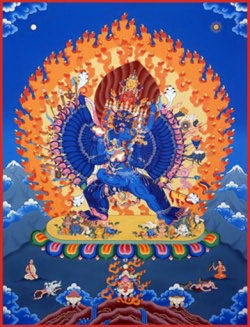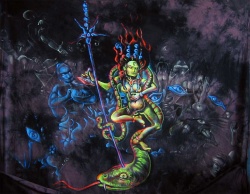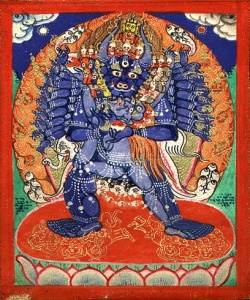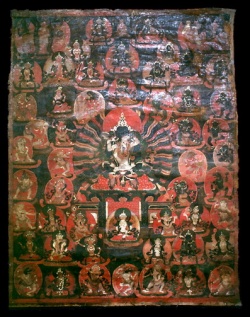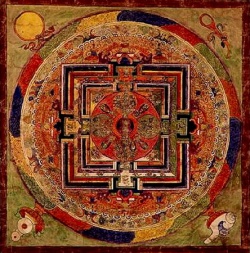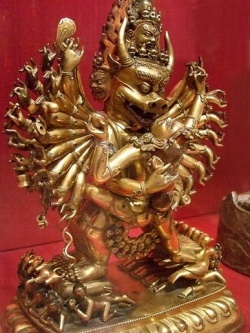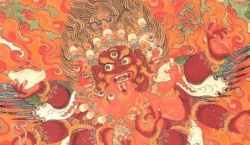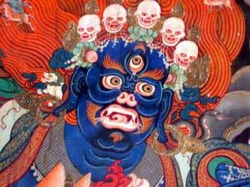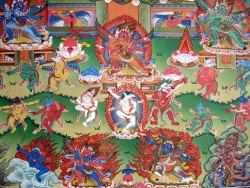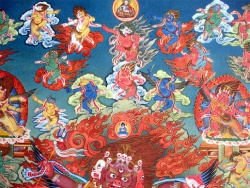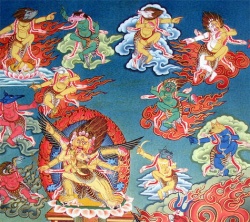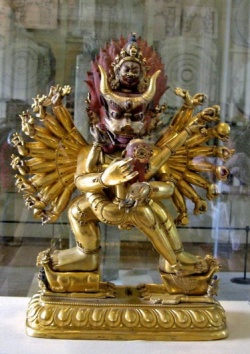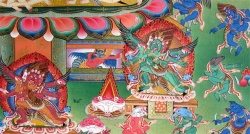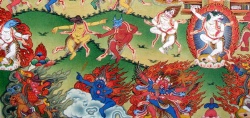Difference between revisions of "Enlightenment: Buddhism Vis-à-Vis Hinduism"
| (One intermediate revision by the same user not shown) | |||
| Line 1: | Line 1: | ||
[[File:0012uu.jpg|thumb|250px|]] | [[File:0012uu.jpg|thumb|250px|]] | ||
| + | |||
| + | |||
| + | |||
| + | |||
| + | |||
<poem> | <poem> | ||
Mr. Sridhar Rana | Mr. Sridhar Rana | ||
[[File:The second bardo.jpg|thumb|250px|]] | [[File:The second bardo.jpg|thumb|250px|]] | ||
| − | [[Buddhist]] [[Himalaya]]: A Journal of [[Nagarjuna]] Institute of Exact Methods | + | [[Buddhist]] [[Himalaya]]: A Journal of [[Nagarjuna]] Institute of Exact [[Methods]] |
[[File:29u35.a1.jpg|thumb|250px|]] | [[File:29u35.a1.jpg|thumb|250px|]] | ||
Vol. VII No. I & II (1996) | Vol. VII No. I & II (1996) | ||
[[File:T107 97.071.jpg|thumb|250px|]] | [[File:T107 97.071.jpg|thumb|250px|]] | ||
| − | It must be understood that [[Hinduism]] and [[Buddhism]] had been sharing the same {{Wiki|culture}} for the last 21500 years which means they share a common language ([[Sanskrit]] of [[Pali]]). Because of this historical situation there are many words used commonly by both which had led many [[scholars]] (especially [[Hindu]] [[scholar]]) to think that they mean exactly the same thing in [[Buddhism]] as in [[Hinduism]], By extending this [[thinking]] one arrives at the wrong conclusion that [[Buddhism]] is another [[form]] or revision of reformation of [[Hinduism]]. | + | It must be understood that [[Hinduism]] and [[Buddhism]] had been sharing the same {{Wiki|culture}} for the last 21500 years which means they share a common [[language]] ([[Sanskrit]] of [[Pali]]). Because of this historical situation there are many words used commonly by both which had led many [[scholars]] (especially [[Hindu]] [[scholar]]) to think that they mean exactly the same thing in [[Buddhism]] as in [[Hinduism]], By extending this [[thinking]] one arrives at the wrong conclusion that [[Buddhism]] is another [[form]] or revision of reformation of [[Hinduism]]. |
| + | |||
[[File:Zhi-Khro Bardo.jpg|thumb|250px|]] | [[File:Zhi-Khro Bardo.jpg|thumb|250px|]] | ||
| − | First of all it is wrong to say that [[Buddhism]] is either a branch or are a formation of [[Hinduism]], [[Buddhism]] is actually a {{Wiki|paradigm}} shift from not only [[Hinduism]] but also all other [[religious]] systems. Secondly words used commonly in both [[Hinduism]] and [[Buddhism]] do not mean the same thing, In fact very often they mean almost opposite and certainly at all times they point at two different paradigms. | + | First of all it is wrong to say that [[Buddhism]] is either a branch or are a formation of [[Hinduism]], [[Buddhism]] is actually a {{Wiki|paradigm}} shift from not only [[Hinduism]] but also all other [[religious]] systems. Secondly words used commonly in both [[Hinduism]] and [[Buddhism]] do not mean the same thing, In fact very often they mean almost opposite and certainly at all times they point at two different {{Wiki|paradigms}}. |
| + | |||
| + | |||
[[File:400u3e356.jpg|thumb|250px|]] | [[File:400u3e356.jpg|thumb|250px|]] | ||
I would like to elucidate some of these points which would effect the meaning in the two systems directly or in directly. | I would like to elucidate some of these points which would effect the meaning in the two systems directly or in directly. | ||
| Line 15: | Line 23: | ||
First of all we always find in the [[Hindu]] context that [[illusion]] is removed so that the [[Brahman]] can be revealed. Thus [[samsara]] is [[illusion]] and [[Brahman]] is the only thing behind the [[samsara]] or as the base of the [[samsara]]. Only when the [[illusion]]-[[samsara]] vanishes is the [[Non-dual]] [[Brahman]] [[manifest]]. | First of all we always find in the [[Hindu]] context that [[illusion]] is removed so that the [[Brahman]] can be revealed. Thus [[samsara]] is [[illusion]] and [[Brahman]] is the only thing behind the [[samsara]] or as the base of the [[samsara]]. Only when the [[illusion]]-[[samsara]] vanishes is the [[Non-dual]] [[Brahman]] [[manifest]]. | ||
[[File:Wrat eity.jpg|thumb|250px|]] | [[File:Wrat eity.jpg|thumb|250px|]] | ||
| + | |||
| + | |||
However in the [[Buddhist]] context the [[Illusion]] is not removed but rather seen as [[jnana]] itself-transformed into [[Jnana]]. And this [[Jnana]] is not something that is the support or base of [[samsara]]. It is the [[knowledge]] of the true mode of [[existence]] of [[samsara]] itself that is [[jnana]]. And furthermore [[samsara]] is not [[illusion]] which will vanish and only the [[Brahman]] will remain. In [[Buddhism]] [[samsara]] is [[pratityasamutpada]] like all [[illusion]]. So it is only like an [[illusion]] and cannot end. What ends is the wrong [[experience]] of it as really [[existing]] (skt. [[svabhava]] [[siddha]]). The [[jnana]] that is {{Wiki|synonymous}} with [[liberation]] is not of an [[eternal]] [[unchanging]] [[Brahman]] [[beyond]] [[Samsara]] but rather of the true mode of [[existence]] of [[Samsara]] itself. | However in the [[Buddhist]] context the [[Illusion]] is not removed but rather seen as [[jnana]] itself-transformed into [[Jnana]]. And this [[Jnana]] is not something that is the support or base of [[samsara]]. It is the [[knowledge]] of the true mode of [[existence]] of [[samsara]] itself that is [[jnana]]. And furthermore [[samsara]] is not [[illusion]] which will vanish and only the [[Brahman]] will remain. In [[Buddhism]] [[samsara]] is [[pratityasamutpada]] like all [[illusion]]. So it is only like an [[illusion]] and cannot end. What ends is the wrong [[experience]] of it as really [[existing]] (skt. [[svabhava]] [[siddha]]). The [[jnana]] that is {{Wiki|synonymous}} with [[liberation]] is not of an [[eternal]] [[unchanging]] [[Brahman]] [[beyond]] [[Samsara]] but rather of the true mode of [[existence]] of [[Samsara]] itself. | ||
[[File:WFBardo-9.jpg|thumb|250px|]] | [[File:WFBardo-9.jpg|thumb|250px|]] | ||
| + | |||
| + | |||
Difference between [[Advaya]] and [[advaita]] | Difference between [[Advaya]] and [[advaita]] | ||
[[File:Pvb1106.jpg|thumb|250px|]] | [[File:Pvb1106.jpg|thumb|250px|]] | ||
Although both [[Jnana]] are called [[non-dual]], here too they mean two different things. [[Non-dual]] ([[advaita]]) in the [[Hindu]] context mean ([[divitiyam nasti]]). There is no second [[substance]] except the [[Brahman]] is the only thing that [[exists]]. This should be called {{Wiki|Monism}} rather than [[Non-dualism]]. The [[word]] [[eka vastu vada]] would be closed that [[advaita]]. | Although both [[Jnana]] are called [[non-dual]], here too they mean two different things. [[Non-dual]] ([[advaita]]) in the [[Hindu]] context mean ([[divitiyam nasti]]). There is no second [[substance]] except the [[Brahman]] is the only thing that [[exists]]. This should be called {{Wiki|Monism}} rather than [[Non-dualism]]. The [[word]] [[eka vastu vada]] would be closed that [[advaita]]. | ||
[[File:WFBardo-5.jpg|thumb|250px|]] | [[File:WFBardo-5.jpg|thumb|250px|]] | ||
| − | However [[Buddhism]] usually uses [[advaya]] (only sometimes is [[advaita]] used) and here it means 'not two' i.e. free from the [[two extremes]] (skt. [[dvaya anta mukta]]) of [[samaropa]] (the tendency to see things as really [[existing]]) and [[apavada]] (the tendency to see things as non-existing). Which would include the [[existence]] of the [[grahaka]] and [[grahya]] too. [[Advaya]] is not of a thing (the one and only thing) like [[Brahma]] but a description of the [[Svarupa]] of [[samsara]]. That is why the [[samsara]] which is like [[illusion]] transforms into [[Advaya Jnana]] in [[Buddhism]] whereas in [[Hinduism]] the [[illusory]] [[samsara]] vanishes and the true [[eternal]] [[unchanging]] [[Brahman]] dawns. That is why [[Gampopa]] sans (May [[illusion]] dawn as [[wisdom]]...) | + | |
| + | |||
| + | However [[Buddhism]] usually uses [[advaya]] (only sometimes is [[advaita]] used) and here it means 'not two' i.e. free from the [[two extremes]] (skt. [[dvaya anta mukta]]) of [[samaropa]] (the tendency to see things as really [[existing]]) and [[apavada]] (the tendency to see things as [[non-existing]]). Which would include the [[existence]] of the [[grahaka]] and [[grahya]] too. [[Advaya]] is not of a thing (the one and only thing) like [[Brahma]] but a description of the [[Svarupa]] of [[samsara]]. That is why the [[samsara]] which is like [[illusion]] transforms into [[Advaya Jnana]] in [[Buddhism]] whereas in [[Hinduism]] the [[illusory]] [[samsara]] vanishes and the true [[eternal]] [[unchanging]] [[Brahman]] dawns. That is why [[Gampopa]] sans (May [[illusion]] dawn as [[wisdom]]...) | ||
[[File:WFBardo-4.jpg|thumb|250px|]] | [[File:WFBardo-4.jpg|thumb|250px|]] | ||
| + | |||
| + | |||
There are tow [[traditions]] of explaining [[advaya]] in [[Buddhism]]. One is called Vast [[lineage]] (skt. Vaipulay [[parampara]]) of [[Asanga]]-[[Vasubandyhu]] based on the Five works of [[Maitreya]] which emphasizes [[subject]] [[object]] (skt. [[grahaka-grahya]]) [[duality]]. But unlike the various [[forms]] of [[Vedanta]] they neither merge into one while or nor does the [[grahya vanishas]] [[illusion]] and only the [[eternal]] [[grahaka]] remain. Here they are found to be untenable. From the very beginning. And what remains is [[emptiness]]. This system had many great [[teachers]] like [[Dignaga]]-[[Dharmakirti]]. | There are tow [[traditions]] of explaining [[advaya]] in [[Buddhism]]. One is called Vast [[lineage]] (skt. Vaipulay [[parampara]]) of [[Asanga]]-[[Vasubandyhu]] based on the Five works of [[Maitreya]] which emphasizes [[subject]] [[object]] (skt. [[grahaka-grahya]]) [[duality]]. But unlike the various [[forms]] of [[Vedanta]] they neither merge into one while or nor does the [[grahya vanishas]] [[illusion]] and only the [[eternal]] [[grahaka]] remain. Here they are found to be untenable. From the very beginning. And what remains is [[emptiness]]. This system had many great [[teachers]] like [[Dignaga]]-[[Dharmakirti]]. | ||
[[File:Vajrabhairav.jpg|thumb|250px|]] | [[File:Vajrabhairav.jpg|thumb|250px|]] | ||
| − | The second [[lineage]] called the Profound (skt. [[gambhira]] [[parampara]]) starts with [[Nagarjuna]] through famous [[teachers]] like [[Arya]] [[Deva]], [[Buddhapalita]], [[Bhavaviveka]], [[Chandrakirti]], [[Shanti Deva]] and [[Atisha]]. There were many other famous [[teachers]] like [[santarakshita]], [[Kamalashila]], who also gave synthetic interpretations of [[Advaya]] using both [[traditions]]. | + | |
| + | |||
| + | The second [[lineage]] called the Profound (skt. [[gambhira]] [[parampara]]) starts with [[Nagarjuna]] through famous [[teachers]] like [[Arya]] [[Deva]], [[Buddhapalita]], [[Bhavaviveka]], [[Chandrakirti]], [[Shanti Deva]] and [[Atisha]]. There were many other famous [[teachers]] like [[santarakshita]], [[Kamalashila]], who also gave {{Wiki|synthetic}} interpretations of [[Advaya]] using both [[traditions]]. | ||
[[File:WFBardo-11.jpg|thumb|250px|]] | [[File:WFBardo-11.jpg|thumb|250px|]] | ||
| − | Any [[Buddhist]] {{Wiki|hermeneutics}} must be based in one of these {{Wiki|hermeneutics}} must be based in one of ehrese {{Wiki|hermeneutics}} or their various branches like sakara [[yogachara]], [[nirakara]] [[yogachara]], [[yogachara]] [[sautrantica]] [[Madhyamika]], [[Yogachara]] [[Svcatantrica]] [[Madhaymika]]. [[Prasangica]] [[Madhyamika]], and [[Svatantrica]] [[Madhyamika]] etc. Just because one [[Understands]] [[Sanskrit]] or [[Tibetan]] one cannot interpret the [[sastras]] as we like giving straight forward meanings to these [[sastras]]. Any interpretation must belong to one of these {{Wiki|hermeneutical}} methodologies. Otherwise it becomes one's own private [[idea]] of what these [[sastra]] are [[teaching]] . That is why Many [[Hindu]] [[scholars]] have misinterpreted the [[Buddhist]] [[sastras]] and claimed that the [[Buddhist]] [[Sastras]] are [[teaching]] the same thing found in the [[Hindu]] [[Sastra]]. But it is unfortunate that even so called [[Buddhist]] [[scholars]] or those who are [[favourable]] to [[Buddhism]] but have not studied under any [[lineage]] [[masters]] belonging to any other the above [[hemeneutics]] have interpreted the [[Sastras]] simply on the basis of [[understanding]] he [[Sanskrit]] [[language]]. Such interpretation are personal [[ideas]] and not true [[Buddhist]] hermeneutics and if analyzed one will find many contradiction and inconsistencies. | + | |
| + | |||
| + | Any [[Buddhist]] {{Wiki|hermeneutics}} must be based in one of these {{Wiki|hermeneutics}} must be based in one of ehrese {{Wiki|hermeneutics}} or their various branches like [[sakara]] [[yogachara]], [[nirakara]] [[yogachara]], [[yogachara]] [[sautrantica]] [[Madhyamika]], [[Yogachara]] [[Svcatantrica]] [[Madhaymika]]. [[Prasangica]] [[Madhyamika]], and [[Svatantrica]] [[Madhyamika]] etc. Just because one [[Understands]] [[Sanskrit]] or [[Tibetan]] one cannot interpret the [[sastras]] as we like giving straight forward meanings to | ||
| + | |||
| + | these [[sastras]]. Any [[interpretation]] must belong to one of these {{Wiki|hermeneutical}} methodologies. Otherwise it becomes one's [[own]] private [[idea]] of what these [[sastra]] are [[teaching]] . That is why Many [[Hindu]] [[scholars]] have misinterpreted the [[Buddhist]] [[sastras]] and claimed that the [[Buddhist]] [[Sastras]] are [[teaching]] the same thing found in the [[Hindu]] [[Sastra]]. But it is unfortunate that even so called [[Buddhist]] [[scholars]] or those who are [[favourable]] to [[Buddhism]] but have not studied under any | ||
| + | |||
| + | [[lineage]] [[masters]] belonging to any other the above [[hemeneutics]] have interpreted the [[Sastras]] simply on the basis of [[understanding]] he [[Sanskrit]] [[language]]. Such [[interpretation]] are personal [[ideas]] and not true [[Buddhist]] {{Wiki|hermeneutics}} and if analyzed one will find many {{Wiki|contradiction}} and inconsistencies. | ||
[[File:WFBardo-10.jpg|thumb|250px|]] | [[File:WFBardo-10.jpg|thumb|250px|]] | ||
| − | |||
| − | Notice, I say valid study, valid study means study with valid [[lineage]] [[teachers]] (not just somebody who [[knows]] [[Sanskrit]] or [[Tibetan]] and happens to be alama or [[Vajracharya]] by [[caste]] as is found among Tamangs or Newars). Valid [[lineage]] [[Masters]] teach according to historically accepted [[Buddhist]] {{Wiki|hermeneutics}} and do not give their won personal [[self]] contradictory interpretations. Such a [[Master]] had studied with someone who belongs to one or more of these {{Wiki|hermeneutical}} [[lineage]]. Such study is not merely Buddhivilas but a proper base for [[srutamayi]] and cintanamayi [[Bhavana]] create the [[correct views]], which itself would be the proper foundation of or proper [[Buddhist]] [[bhavana]] i.e the third Bhavanamaya avastha, Simply doing nadi-vayu-tilak [[yoga]] without such a base it the same as doing [[Hindu]] [[Bhavana]] even if it is part of [[Hevajra]] or [[Cakrasamvara]] or [[Vajrabhairava]] or [[Kalacakra]] practice. | + | There are some who say that they are [[mediators]] and they are not [[interested]] in such theories. Some say such theories are only Buddhi-vilasa and others say that the [[lineage]] of [[meditation]] land the [[lineage]] of [[sastra]] study have no relationship. Such statements prove that such so called [[Buddhism]] [[teachers]] are only half backed. First of all I would like to remind them that [[Asanga]], [[Vasubandhuy]], [[Nagarjuna]], [[Chandrakirti]], [[Santideva]] and [[Atisha]] wer all great [[mediators]] and they are considered as among |
| + | |||
| + | the greatest [[Buddhist masters]] in history among the greatest [[Buddhist masters]] in history They and [[infinite]] the such [[masters]] believe that it was necessary to acquire the correct Darsan to be able to truly practice the [[Buddhist meditation]]. Of course, [[Urgyen]] [[Rinpoche]] says, this correct [[view]] can be had in the [[form]] of simple [[pith instructions]] from a qualified [[master]] instead of an elaborate detailed study of the [[sastra]], but one must still listen and think about and discuss and finally understand clearly the | ||
| + | |||
| + | import of the [[Pith instruction]] which is the same thing elaborated in the [[sastra]], so to say to [[meditate]] and does not need to study at all is utter non-sense. It is only after having understood the [[view]] correctly that correct [[Buddhist]] [[mediation]] can take place. Otherwise their is no difference between Hindu-Sufi-Christian-Tao and [[Buddhist Meditation]]. Some [[Newar]] [[Vajracharya]], think | ||
| + | |||
| + | that just taking [[initiation]] [[Cakrasambhara]] doing its ,[[mantras]] and doing the [[nadi]] [[chakra]] [[yoga]] related to it is enough and their is no need to study, If that is so why does the [[Hevajra Tantra]] etc say very clearly that one must study first [[vaibhasika]] | ||
| + | |||
| + | then [[sautrantic]] them [[Yogachara]] then [[Madhyamika]] then only should one be given [[Abhiseka]]. Secondly, if just doing Nadivayu-tilak yagia in enough to have [[Mahamudra]] [[siddhi]] then the all the thousands of [[Hindu]] [[Masters]] who practice [[Kundalini]] [[yoga]] are alos [[Buddhas]]. such statements as above completely contradicts the very basic {{Wiki|concept}} found in [[Theravada]], [[Mahayana]] and [[Vajrayana]] that [[Meditation]] progresses from [[Srutamayi]] to Cintamayi to Bhavanamayai, How can there be [[sruti]] and cintana without valid study of valid [[sastra]]. | ||
| + | |||
| + | |||
| + | Notice, I say valid study, valid study means study with valid [[lineage]] [[teachers]] (not just somebody who [[knows]] [[Sanskrit]] or [[Tibetan]] and happens to be alama or [[Vajracharya]] by [[caste]] as is found among [[Tamangs]] or [[Newars]]). Valid [[lineage]] [[Masters]] teach according to historically accepted [[Buddhist]] {{Wiki|hermeneutics}} and do not give their won personal [[self]] [[contradictory]] interpretations. Such a [[Master]] had studied with someone who belongs to one or more of these {{Wiki|hermeneutical}} [[lineage]]. Such study is not merely Buddhivilas but a proper base for [[srutamayi]] and cintanamayi [[Bhavana]] create the [[correct views]], which itself | ||
| + | |||
| + | would be the proper foundation of or proper [[Buddhist]] [[bhavana]] i.e the third Bhavanamaya [[avastha]], Simply doing nadi-vayu-tilak [[yoga]] without such a base it the same as doing [[Hindu]] [[Bhavana]] even if it is part of [[Hevajra]] or [[Cakrasamvara]] or [[Vajrabhairava]] or [[Kalacakra]] practice. | ||
It is true that there are different [[lineages]] for study and [[meditation]] but to say that they are not {{Wiki|interrelated}} is simply to show ones [[ignorance]]. | It is true that there are different [[lineages]] for study and [[meditation]] but to say that they are not {{Wiki|interrelated}} is simply to show ones [[ignorance]]. | ||
| Line 38: | Line 74: | ||
[[Tathagatagarbha]] | [[Tathagatagarbha]] | ||
| − | |||
| − | Since the Ratnagotra makes it clear that [[sugatagarbha]] is just a {{Wiki|cognate}} [[word]] for [[sunyata]], the [[Sugatagarbha]] and [[Brahman]] cannot be the same. The {{Wiki|confusion}} is often created by the statement the [[Sugata]] [[garbha]] the [[Buddha nature]] [[exists]] in all [[sentient beings]]. The [[word]] '[[exists]]' is the perpetrator of {{Wiki|confusion}}. The '[[exists]]' is only [[Wikipedia:Convention (norm)|conventional]] usage, or giving way to [[Wikipedia:Convention (norm)|conventional]] usage. without its use here one cannot express the fact that his is the mode of abiding of the [[true nature]] of [[mind]] of all [[sentient beings]]. '[[Exists]]' | + | Now I would like to deal with the {{Wiki|concept}} of [[Sugatagarbha]] or [[Tathagatagarbha]] or Dharmadhatuor [[Dharmakaya]]. Many [[Hindu]] [[scholars]] think that these words prove that [[Buddhism]] is basically {{Wiki|speaking}} about the [[Brahman]] of [[Hinduism]]. |
| + | |||
| + | If one studies the [[Ratnagotravibhaga]] and the [[Srimala Sutra]] it is easy to see that they make it very clear that the [[Sugatagarbha]] and [[Sunyata]] are {{Wiki|cognate}} words. [[Sunyata]] is the mode of [[existence]] of all [[dharmas]] [[including]] the [[Mind]] which known this whereas Brahmanis a separate {{Wiki|entity}} altogether [[form]] all [[Dharmas]]. [[Brhaman]] is something that truly [[exist]] | ||
| + | |||
| + | ([[Paramartha]] [[satta]]). [[Sunyata]] is not a thing of Super thing but her mode of [[existence]] of all things and therefore it is nonsense to speak of it as a knowable {{Wiki|epistemologically}} but not as a thing {{Wiki|ontologically}} except interdependently. the | ||
| + | |||
| + | [[Brhaman]] is not [[existing]] interdependently it is parmaretha satta-the one and only truly [[existing]] [[substance]]. The [[Brhaman]] is [[svabhavasiddha]] whereas [[Sunyata]] is nisvabhavata, the [[Brhaman]] is [[svalaksana]] [[siddha]] whereas [[Sunyata]] is a Laksanata. The [[Brahman]] is [[Paramartha]] [[satta]] whereas [[Sunyata]] is the unfindability or a [[bhava]] of such a [[paramartha]] [[satta]] anywhere. | ||
| + | |||
| + | |||
| + | |||
| + | Since the [[Ratnagotra]] makes it clear that [[sugatagarbha]] is just a {{Wiki|cognate}} [[word]] for [[sunyata]], the [[Sugatagarbha]] and [[Brahman]] cannot be the same. The {{Wiki|confusion}} is often created by the statement the [[Sugata]] [[garbha]] the [[Buddha nature]] | ||
| + | |||
| + | [[exists]] in all [[sentient beings]]. The [[word]] '[[exists]]' is the perpetrator of {{Wiki|confusion}}. The '[[exists]]' is only [[Wikipedia:Convention (norm)|conventional]] usage, or giving way to [[Wikipedia:Convention (norm)|conventional]] usage. without its use here one cannot express the fact that his is the mode of abiding of the [[true nature]] of [[mind]] of all [[sentient beings]]. '[[Exists]]' | ||
| − | + | here is a synonymn for 'is the mode of abiding'. The mode of abiding. so '[[exists]]' here does not mean abide' (skt. sthita) but rather' non abidingness (skt. asthita). This is into mode of abiding or the [[sugatagarbha]] {{Wiki|present}} in all [[sentient beings]]. Even in this last sentence the '{{Wiki|present}}' can create the same {{Wiki|confusion}}. 'Present' here would mean {{Wiki|present}} of the absence | |
| − | + | of self-existingness or [[self]]- characteristicness etc. that is positively named '[[sugatagarbha]]' which is said to [[exist]] in all [[sentient beings]]. this [[exists]]' is qualities rather than [[existential]]. It is also more {{Wiki|epistemological}} whereas the [[Brahman]] is more {{Wiki|ontologically}} truly [[existing]]. the [[Brahman]] is not [[non-abiding]] but rather ' kutastha' which mean [[self-abiding]]. | |
| − | |||
| − | |||
| − | That is why the [[Mahapandita]] and [[Siddha]] of the [[Sakya]] [[lineage]], [[Sakya Pandit]] warned 'Every [[body]] speaks about [[Mahamudra]], but if one had no properly understood or [[experienced]] them with the help of a genuine [[lineage]] [[Master]] such a state (indifferent choiceless state of [[awareness]]) is a sure way to [[reborn]] as an [[animal]]'. | + | I have already elaborated on his difference between the [[Sunyata]] [[sugatagarbha]] and the [[Brhaman]] in my article in the [[Buddhist]] [[Himalaya]] Vol VI, 1994-95. the [[word]] [[Samantabhadra]] used in the [[Dzog chen]] [[tradition]] can often mislead [[people]] to believe |
| + | |||
| + | that [[Samantabhadra]] is some [[king]] of a [[god]] in this system. However, there is no [[God]] in any [[form]] of [[Buddhism]] and great [[Buddhist Masters]] like [[Nagarjuna]], Odianaya [[Acharya]], [[Kalyana]] Rakshita have written [[books]] proving that such [[beliefs]] are only for children. So [[Samantabhadra]] cannot be some substitute for [[God]]. [[Samantabhadra]] is a {{Wiki|poetic}} {{Wiki|metaphoric}} | ||
| + | |||
| + | expression for the [[enlightened]] [[state]] i.e. the [[sugatagarbha]] all sentien [[beings]] already possess. This is [[the way things really are]], the way things really [[exist]] from the very beginning However, although this [[state]] is always there and never was not so | ||
| + | |||
| + | because of which it is called [[primordial]] [[enlightenment]], we [[sentient beings]], have apparently wandered from the [[knowledge]] of that which is already there as our true mode of [[existence]] therefore we have to be re0enlightened i.e. come to [[recognize]] the [[primordial]] [[enlightened]] [[state]] already {{Wiki|present}} in us and through practice become established in it. | ||
| + | |||
| + | |||
| + | |||
| + | [[Buddhism]] does not believe, and this applies to the [[Dzogchen]] which is considered a relatively quicker or sudden [[path]], that simply because [[Samantabhadra]]- the [[primordial]] [[enlightenment]] is already {{Wiki|present}} in us from the beginning we can just | ||
| + | |||
| + | [[recognize]] that fact and we become [[enlightened]]. we have to be re-enlightened because we have already wandered off the [[path]] and to be re-enlightened. One needs to remove the [[cause]] why we wandered. The [[cause]] is [[ignorance]]. [[Ignorance]] is basically [[Wikipedia:cognition|cognitive]] but includes the {{Wiki|conditioning}} produced by the [[Wikipedia:cognition|cognitive]] mistake. These | ||
| + | |||
| + | {{Wiki|conditioning}} validates further the mis-cognition which further produces more {{Wiki|conditioning}}. {{Wiki|Conditioning}} is in two [[form]]: Kleshavarana and [[Jneyavarana]]. The refore, to have correct [[cognition]] i.e. true [[recognition]] of [[Samantabhadra]] requires clearing off of the conditionings to some extent. Since [[cognition]] itself is moulded by these conditionings, true | ||
| + | |||
| + | [[recognition]] cannot take place unless the hold of the {{Wiki|conditioning}} on [[cognition]] has been [[relaxed]] to some extent, Bud even this [[recognition]] can only become a pin-prick opening which will naturally be [[conditioned]] by the still extant {{Wiki|conditioning}}. So it is only through years of clearing off the conditionings through [[accumulation of merit]] (skt: [[Punya]] | ||
| + | |||
| + | [[sambhara]]) and glimpsing a6t the [[true nature]] over and over again through [[Jnanasambhara]] that one finally is re-established in the [[state]] of re-enlightenment. Just [[recognizing]] one's true [[unconditioned]] [[state]] is not re-enlightenment. This is the major difference between the teachings of Punja swvami, Raman [[Maharsi]], Adrew cohen, Krishmurti, Nisargadutta {{Wiki|Maharaja}} and Sadyo | ||
| + | |||
| + | {{Wiki|Vedantic}} Systems like Astavakra {{Wiki|Gita}}, Jivan mlukta {{Wiki|Gita}} etc. and [[Dzog chen]]. They believe that just [[recognizing]] that one's [[true nature]] is [[primordially]] [[unconditioned]] is enough to free man. as we have seen earlier no [[forms]] of [[Buddhism]] agrees with that {{Wiki|concept}}. The glimpse is only of the seed of [[enlightenment]] and is not the full | ||
| + | |||
| + | [[enlightenment]] or [[enlightened]] [[state]] itself. There is a difference in the Tathagatagharbha and the [[Tatha]] gata.But there is another difference too. What they call the [[unconditioned]] is the [[Atman]] as found in [[Shastras]] of [[Hinduism]]. What [[Dzog chen]] of the [[Nyingma]], the [[Mahamudra]] of Kagyr and [[Lamdrey]] of [[Sakya]], the texts of the 'Profound and Vast' [[tradition]] call the | ||
| + | |||
| + | [[unconditioned]] is the Tathagatagharbha, the [[Samantabhadra]], [[Emptiness]], nighsvabhavata, [[Anatma]], as we have seen these zare diametrically opposed {{Wiki|paradigms}}. | ||
| + | |||
| + | |||
| + | |||
| + | There are however two schools concerning the [[Tathagatagarbha]], some [[Nyingma]] and Dagyiu based in the 'Vast lineage(skt. [[Vaipulya]]) of [[asanga]] interprete it as {{Wiki|present}} in full [[form]] (not in seed) [[form]] but the veils covering it is gradually unveiled through practice. some [[Sakyapas]] based in the 'Profound' [[tradition]] of [[Nagarjuna]] however, interprete that it is only in seed [[form]] and has to developed into its full [[form]] through practice. | ||
| + | |||
| + | |||
| + | |||
| + | So what can be said in [[Buddhist]] [[language]] is that [[people]] like Raman Masharsi and [[Wikipedia:Jiddu Krishnamurti|Krishnamurti]] have only the base but on [[path]] related to that base and therefore [[logically]] no fruit too. Many of these [[teachers]] tech and indifferent [[state]] which is choiceless to be the base or the [[enlightened]] [[state]], It must be understood very clearly that, that is | ||
| + | |||
| + | not the [[state]] of [[Mahamudra]] or [[Dzog chen]]. Toandy [[form]] of [[Buddhism]] such a [[state]] of choiceless [[Awareness]] (as [[taught]] in the shive asutyras and [[Kashmira]] [[shaiva]] school) is [[moha]] and not the [[enlightened]] [[state]]. Being indifferent | ||
| + | |||
| + | and untouched by [[pain]], [[happiness]], [[anger]] and [[attachment]], remaining in a [[king]] of choiceles [[Awareness]] in not | ||
| + | |||
| + | [[Dzogchen]] or [[Mahamudra]] although they may [[sound]] very close teach other. Such a [[state]] is to a [[state]] of [[moha]] or [[delusion]]. [[Dzogchen]] or [[Mahamudra]] is free from not only [[attachment]] or [[aversion]] but also from the choiceless [[state]] which is indifferent to them, the [[world]] etc. | ||
| + | |||
| + | |||
| + | |||
| + | That is why the [[Mahapandita]] and [[Siddha]] of the [[Sakya]] [[lineage]], [[Sakya Pandit]] warned 'Every [[body]] speaks about [[Mahamudra]], but if one had no properly understood or [[experienced]] them with the help of a genuine [[lineage]] [[Master]] such a [[state]] (indifferent choiceless [[state]] of [[awareness]]) is a sure way to [[reborn]] as an [[animal]]'. | ||
| + | |||
| + | |||
| + | It is also not a question of merely eschewing all [[conceptuality]] and just remaining in a [[non-conceptual]] [[state]]. when non-conceptuality is use din the context of [[Dzogchen]] or [[Mahamudra]] it is the [[Yogi]] [[pratyaksa]] the {{Wiki|unity}} of [[Sunyata]] [[Prabhasvara]] in which Sunyatra [[Prabhasvara]] and the [[consciousness]] become one like [[water]] poured into [[water]]. | ||
| + | |||
| + | |||
| + | This is the Tahtagatyagarbha which is very different from the [[non-conceptual]] [[experience]] of a choiceless [[awareness]] or a [[Brhaman]] or Parasamvit. Many is called [[teachers]] are confused by the [[word]] [[non-conceptual]] to describe their [[experience]], it must be the same as what they believe is their [[non-conceptual]] states without realising the possibility of may kinds of [[non- | ||
| + | |||
| + | conceptual]] states. Perhaps things get clearer of one [[understands]] that in the [[Buddhist]] context [[non-conceptual]] is {{Wiki|synonymous}} with [[pratyaksa]]- especially [[Yogi]] pratyak,sa, Ahnd it is always and [[experience]] of something which becomes non- | ||
| + | |||
| + | [[dualistically]] one with the experiencing [[consciousness]]. so it is not just a [[non-conceptual]] [[state]] that [[Buddhist traditions]] are talking about; but rather a particular type of [[non-conceptual]] [[yogi]] [[pratyaksa]] [[experience]] of emp6tiness or the [[Tathagatagarbha]] that they mean by [[non-conceptual]] (skt. [[avikapla]] or [[nisprapanca]]). | ||
| − | |||
| − | |||
{{Wiki|Concept}} of [[Trikaya]] : | {{Wiki|Concept}} of [[Trikaya]] : | ||
| − | |||
| − | |||
| − | Only such a [[person]] who although never being born, [[emanations]] are continually [[emanating]] for the sake of [[sentient beings]], had realised {{Wiki|Totality}}. and only such a [[person]] is [[enlightened]]. [[People]] who have no [[manifested]] such capacities are merely conceptually [[enlightened]] not truly [[enlightened]]. | + | After having said that I would like to take up the {{Wiki|concept}} of [[Dharmakaya]], [[Sambhogakaya]] and [[Nirmanakaya]]. One way of [[looking at]] it is [[Dharmakaya]] as [[Sunyata]]. [[Rupakaya]] ([[Sambhogakaya]] and [[Nirmanakaya]]) is [[pratityasamlutpada]]. We can divide all the there doors (skt. [[kaya]], [[vak]], [[citta]]) into the [[three kayas]] each, a very [[god]] {{Wiki|metaphor}} is the |
| + | |||
| + | {{Wiki|crystal}} ball. The {{Wiki|crystal}} ball itself is colorless representing [[emptiness]]. Even though it is colourless itself. it has the capacity to reflect all the seven colours if the right [[causes]] and [[conditions]] are {{Wiki|present}}. This capacity is the capacity [[emptiness]] to appear as [[interdependent origination]]. This is the [[Sambhogakaya]] and if the right [[causes]] and [[conditions]] | ||
| + | |||
| + | appear i.e. if a torch [[light]] is flashed into the {{Wiki|crystal}} ball multi- oloured [[light]] will project out of it and appear on the wall. This is the actual [[appearance]] of the [[empty]] [[Samsara]]. This is called [[Nirmanakaya]]. | ||
| + | |||
| + | |||
| + | |||
| + | It is of utmost importance to understand these three [[Kayas]] to fully understand what is meant buy [[enlightenment]] in Mahayana-Vajrayana [[Buddhism]]. we find the [[word]] [[enlightenment]] used by [[Hinduism]] an also by [[teachers]] such as Punja Svami, Andrew cohen, Nisargadutta, J. Krishnamurtyi and U.G. [[Wikipedia:Jiddu Krishnamurti|Krishnamurti]] but they do not mean the same [[enlightenment]] | ||
| + | |||
| + | as the [[enlightenment]] of [[Buddhism]]. In [[Mahayana Buddhism]] [[enlightenment]] means full {{Wiki|realisation}} and else is {{Wiki|inferior}} [[state]], Because of the popular [[Hindu]] [[definition]] of [[mukti]] as no more [[birth]] in [[samsara]] which is also found in [[Mahayana]] and [[Theravada]] many [[people]] confuse about [[enlightenment]] and [[Mukti]]. [[Mukti]] is no returning to [[samsara]] anymore. It is not [[enlightenment]]. A [[person]] who attains [[Mukti]] goes to one of the [[pure realms]] like Sukhavali etc. | ||
| + | |||
| + | from where he is not born bake in this [[world]] until he become [[enlightened]]. But [[enlightenment]] means that he has realised total [[reality]] as it is (skt. Yathabyhuta) which means he has actualised all the [[three kayas]]. Actualising the [[three kayas]] means [[attaining]] the three [[Vajra]] [[Kayas]]. [[Dharmakaya]] being the relisation of [[emptiness]] ([[anatma]]) there is no [[birth]] and | ||
| + | |||
| + | [[death]] any more because there never was one who had taken [[birth]]. It is not destruction of some really [[existing]] [[Atman]]. It is the {{Wiki|realisation}} that there never was any [[Atman]] from the begining which means there never was anyone who took [[birth]] from the very begining. However, true and in-depth {{Wiki|realisation}} of [[dharmakaya]] also means relisation of the [[Rupakaya]]. just as true | ||
| + | |||
| + | realisation of [[emptiness]] also entail true {{Wiki|realisation}} of [[Pratityasamutpada]]. There fore even though there is no [[birth]], through the proper [[causes]] and [[conditions]] of [[compassion]] etc. [[Nirmanakaya]] [[emanate]] continuously to help all [[sentient beings]]. it is this [[Nirmanakaya]] which is wrongly called Avatari [[lama]] by {{Wiki|Nepalese}} [[Buddhists]] due to the influence of {{Wiki|Hindusm}}. But technically they are no [[avataras]] but [[emanations]] [[Nirmanakayas]] are not personalities born again but rather | ||
| + | |||
| + | emanated (skt. [[nirmita]]) from [[causes]] and [[conditions]] due to the innate capacity of [[Dharmakaya]]. This innate capacity is [[Sambhogakaya]]. A [[personality]] if [[reborn]] can be only one. [[Nirmanakaya]] can be [[infinite]]. | ||
| + | |||
| + | |||
| + | |||
| + | Only such a [[person]] who although never being born, [[emanations]] are continually [[emanating]] for the [[sake]] of [[sentient beings]], had realised {{Wiki|Totality}}. and only such a [[person]] is [[enlightened]]. [[People]] who have no [[manifested]] such capacities are merely conceptually [[enlightened]] not truly [[enlightened]]. | ||
| + | |||
| + | This is the meaning of the statement made but the [[Eight Karmapa]] when he was born. He turned around to his mother and stated, " I am the {{Wiki|unborn}} [[Karmapa]]". The {{Wiki|unborn}} is the [[empty]] [[Dharmakaya]], however the apparently born [[Karmapa]] who made this statement is the [[Nirmanakaya]] of this very {{Wiki|unborn}} [[empty]] [[Dharmakaya]]. If you have understood [[Madhyamika]] well and understood that pratityasamutpad itself is [[anutpada]] ([[un-produced]] ) you realise that there is no {{Wiki|contradiction}}. | ||
| + | |||
| − | |||
[[Sambhogakaya]] is the capacity of the {{Wiki|unborn}} [[empty]] [[dharmakaya]] {{Wiki|nature}} of [[enlightenment]] and consists of all the qualities like [[omniscience]] etc. | [[Sambhogakaya]] is the capacity of the {{Wiki|unborn}} [[empty]] [[dharmakaya]] {{Wiki|nature}} of [[enlightenment]] and consists of all the qualities like [[omniscience]] etc. | ||
| Line 70: | Line 187: | ||
If a [[person]] does not possess the qualities, he ahs not [[manifested]] the [[Sambhogakaya]], he has no truly [[manifested]] the [[Dharmakaya]] which means according to [[Mahayana Buddhism]] he is not truly [[enlightened]]. | If a [[person]] does not possess the qualities, he ahs not [[manifested]] the [[Sambhogakaya]], he has no truly [[manifested]] the [[Dharmakaya]] which means according to [[Mahayana Buddhism]] he is not truly [[enlightened]]. | ||
| − | There are many such [[Masters]] around especially in [[Hinduism]] or coming from [[Hindu]] background who later claim to be [[Buddhist masters]] but have no {{Wiki|realisation}} of three [[Kayas]]. Such [[people]] cannot be considered as [[enlightened]] [[Buddhist Masters]]. some of them do not even have the faintest [[idea]] what the three [[Kayas]] are about. Those who what tot practice [[Buddhist practices]] and attain the [[Buddhist]] [[enlightenment]] must be sensitive to these issues and not get confused by [[sweet]] talk and oratorship. | + | There are many such [[Masters]] around especially in [[Hinduism]] or coming from [[Hindu]] background who later claim to be [[Buddhist masters]] but have no {{Wiki|realisation}} of three [[Kayas]]. Such [[people]] cannot be considered as [[enlightened]] [[Buddhist Masters]]. some of them do not even have the faintest [[idea]] what the three [[Kayas]] are about. Those who what tot practice [[Buddhist practices]] and attain the [[Buddhist]] [[enlightenment]] must be [[sensitive]] to these issues and not get confused by [[sweet]] talk and oratorship. |
| + | |||
| − | |||
| − | But even a [[person]] who achieves the [[Vajradharahod]] is still only what is called a [[Chitta]] [[Buddha]]. Meaning his [[minds]] a full [[Buddha]] like [[shakyamuni]] but his [[body]] is not with 32 {{Wiki|superior}} marks and 80 secondary marks like [[Shakyamuni]]. So although he can be called a [[Buddha]] and there is no difference between his [[mind]] and [[Shakyamuni]] or any other [[Buddha]], he has no perfected the Rupakya yet. it is any after collecting vast amounts of [[merit]] by [[emanating]] countless [[emanations]] for the [[benefit]] of others that he will also have the perfect Nirmanakayha liked [[Shakyamuni]], [[Krakuchchanda]], [[Kashyapa]] etc. | + | There are many degrees of [[enlightenment]] in [[Buddhism]]. That is the significance of the {{Wiki|concept}} of [[Ten stages]] (skt. [[Dasa Bhumi]]) A man in the first [[bhumi]] itself is already [[enlightened]] and there for every different from an unenlightened [[person]]. He already has begun to [[manifest]] the three [[Kayas]] to some extent. The actualisation deepens as he moves to [[Second stage]], the thirds |
| + | |||
| + | stage and so on to Seventh [[bhumi]]. From the first to seventh [[bhumi]] is still considered as impure, it is only from the eighth onwards that the [[Nirmanakaya]] begins to [[manifest]] more visibly. From the eight to the tenth are the [[pure]] [[bhumis]]. It is said that many [[devas]] are found from first to sevetn [[bhumi]]; but only [[Gurus]] are found from the eight upwards. It is only when a [[person]] | ||
| + | |||
| + | crosses over the Tenth [[bhumi]] to the No-learning stage (skt6. asaiksapada) or [[Vajradharahood]] according to [[tantra]] that the [[person]] is fully [[enlightened]]. Often in [[Tantra]] we find 134th [[bhumi]] instead of ten but again this is only a question of categories which can be done in many ways. | ||
| + | |||
| + | But even a [[person]] who achieves the [[Vajradharahod]] is still only what is called a [[Chitta]] [[Buddha]]. Meaning his [[minds]] a full [[Buddha]] like [[shakyamuni]] but his [[body]] is not with 32 {{Wiki|superior}} marks and 80 secondary marks like [[Shakyamuni]]. So | ||
| + | |||
| + | although he can be called a [[Buddha]] and there is no difference between his [[mind]] and [[Shakyamuni]] or any other [[Buddha]], he has no perfected the Rupakya yet. it is any after collecting vast amounts of [[merit]] by [[emanating]] countless [[emanations]] for the [[benefit]] of others that he will also have the {{Wiki|perfect}} Nirmanakayha liked [[Shakyamuni]], [[Krakuchchanda]], [[Kashyapa]] etc. | ||
| + | |||
| + | It is said that it took three [[asankhyeya]] [[Kalpas]] for [[Shakyamuni]] to collect enough [[merit]] to have the {{Wiki|perfect}} [[Nirmanakaya]]. According to the [[Tantra]] if the [[Sambhogakaya]] is developed according to [[Tantra]] [[methods]], countless [[emanations]] can be send to collect [[merit]] quicker and faster that in the [[Sutra]] system or method that [[Shakyamuni]] used. | ||
| + | |||
| − | |||
If you understand the [[Buddhist]] [[enlightenment]] correctly based on what has been said, one begins to realise that [[ordinary people]], nowadays, who have no such qualities and claim to be [[enlightened]] [[Master]] are like clowns sitting on the thrones of [[emperors]] caricaturing the [[emperor]]. However, [[people]] have the freedom the define [[enlightenment]] in other ways; but in such a case it is not the [[enlightenment]] of [[Buddhist]] especially [[Mahayana]]-[[Vajrayana]]. | If you understand the [[Buddhist]] [[enlightenment]] correctly based on what has been said, one begins to realise that [[ordinary people]], nowadays, who have no such qualities and claim to be [[enlightened]] [[Master]] are like clowns sitting on the thrones of [[emperors]] caricaturing the [[emperor]]. However, [[people]] have the freedom the define [[enlightenment]] in other ways; but in such a case it is not the [[enlightenment]] of [[Buddhist]] especially [[Mahayana]]-[[Vajrayana]]. | ||
| − | [[People]] like [[Milarepa]], Longchempa, [[Marpa]], Sakyapaandita of [[Tibet]] and Surata [[vajra]], Humkaravajrea, Sasvatvajra, jVakvajra, Jamunagubhaju of [[Nepal]] and [[Naropada]], Tillipade, [[Virupada]], [[Nagarjuna]], [[Atisha]] of [[India]] of the [[Vajrayana]] [[tradition]] and [[Linchi]], [[hogen]], [[Sungsan]], to san unmen of chinga, [[Dogen]], Haquin Banke of [[Japan]] are at least in one of the higher [[bhumi]] if not [[chitta]] [[Buddha]]. | + | [[People]] like [[Milarepa]], Longchempa, [[Marpa]], Sakyapaandita of [[Tibet]] and [[Surata]] [[vajra]], Humkaravajrea, Sasvatvajra, jVakvajra, Jamunagubhaju of [[Nepal]] and [[Naropada]], Tillipade, [[Virupada]], [[Nagarjuna]], [[Atisha]] of [[India]] of the [[Vajrayana]] [[tradition]] and [[Linchi]], [[hogen]], [[Sungsan]], to san unmen of chinga, [[Dogen]], Haquin Banke of [[Japan]] are at least in one of the higher [[bhumi]] if not [[chitta]] [[Buddha]]. |
| + | |||
| + | |||
| + | |||
| + | All of these [[manifested]] the display of [[Sambhogakaya]] [[manifestations]] throughout their [[life]] and especially during [[death]]. the [[death]] process of an [[enlightened]] [[beings]] is a very special occasion to gauge his depth. If he is [[enlightened]], there is no question but that [[Sambhogakaya]] [[manifestations]] will take place during and after his [[death]]. [[Rainbows]] in the sky are around the | ||
| + | |||
| + | house of [[dead]] [[body]]. The [[body]] shrinking to the size of 8-16 years old or in very advanced cases the [[body]] either vanishing or [[transforming]] into [[light]] are some of the [[manifestations]]. Manras and statures of [[deities]] engraving in their {{Wiki|bones}}, special [[forms]] like [[stupas]] etc. found in th ashes are others. Earthquakes, storms, [[animals]] and birds [[beings]] disturbed, some | ||
| + | |||
| + | parets of the [[body]] remaining intact after [[cremation]] are some others [[manifestations]]. There have been may well known [[Gurus]] who have clamed to be [[Buddha's]] or [[enlightened]] in the near {{Wiki|past}} whose [[death]] showed absolutely [[manifestation]]. Such [[people]] cannot be considered [[enlightened]] in the [[Buddhist]] [[sense]]. as Karme Chagmed put it, "the corpse of an ordinary many the bed of a great [[scholar]] [[Guru]]" | ||
| + | |||
| − | |||
[[Faith]] and [[Devotion]]: | [[Faith]] and [[Devotion]]: | ||
| − | |||
| − | |||
| − | A genuine [[Guru]] in [[Vajrayana]] does not depend on how his [[personality]] is because most of the [[personality]] we see in him are own {{Wiki|characteristics}}, we see reflected on him which we have to use as out [[path]]. A genuine [[Master]] is someone who has received instructions from a genuine [[lineage]] [[teacher]] belonging to [[pure]] unbroken [[siddha]] [[lineage]]. Such a [[lineage]] is not decided by [[caste]] or family although families can preserve such [[lineage]]. Such a [[lineage]] must produce [[enlightened]] and learned [[masters]] in every generation. Than only can it be considered as [[pure]] and unbroken [[enlightened]] [[lineage]]. | + | Since there is no [[god]] in [[Buddhism]], [[Bhakti]] as found in [[Mahayana]] [[Vajrayana]] cannot mean the same thing as in the [[Bhakti]] {{Wiki|cults}} of [[Hinduism]]. First of all [[Bhakti]] ([[devotion]]) ins always towards the [[Guru]]. But he [[Guru]] plays a very special role in [[Vajrayana]]. Unlike [[Theravada]] and [[Mahayan]] where the Buyres is only a [[Kalyanamitra]] i.e. some [[body]] that points the way, |
| + | |||
| + | in [[Vajrayana]] the [[Guru]] is not merely a [[Kalayanamitra]], he is also the way itself. This second role is more important in the role of a [[Guru]] in [[Vajrayana]]. The [[guru]] is the [[State of Enlightenment]]. but since unlike [[Sutrayana]] which are cause-vehicle he is not [[state]] of [[Enlightenment]]. But Since unlike [[Sutrayana]] which are cause-vehicle he is not just a representative of the goal, the | ||
| + | |||
| + | {{Wiki|ideal}} of the goal to de [[attained]]: he is used as the [[path]] itself. [[Vajrayana]] is also called effect-vehicle (skt. [[phalayana]]) because it uses the effect in the [[path]] instead of creating [[cause]] and [[conditions]] (skt. [[hetu-pratyaya]]) as in | ||
| + | |||
| + | [[cause]] [[vehicle]] to attain the effect one day. since the [[Guru]] is the [[Enlightened]] [[state]] ( he [[beings]] [[enlightened]]), he is used as the [[Path]] and the [[Path]]. He reflects ones [[own]] [[true nature]] and all ones [[defilements]] (skt. [[Klesha]]) and | ||
| + | |||
| + | obstructions (skt. [[avaranas]]).It is when one truly see the [[guru]] as [[Primordially pure]] that one has also recognised ones [[own]] [[primordial purity]] and seen that the [[Guru]] was always one's [[own]] [[primordially pure]] [[Sugatagarbha]]. | ||
| + | |||
| + | |||
| + | |||
| + | Therefor [[devotion]] here is [[dedication]] and [[devotion]] to the [[path]] {{Wiki|conventionally}} and [[devotion]], [[faith]], [[dedication]] in ones [[own]] [[Sugatagarbha]]. That is why in [[tantra]] the [[Guru]] is not an {{Wiki|individual}} who gives you | ||
| + | |||
| + | [[abhiseka]] but the [[Buddha]] himself or even more accurately ones [[own]] [[Buddhata]] reflected in the [[personality]] of the [[initiation]] giver. This is very important for the [[tantric path]] which uses the [[principle]] of effect-vehicle (using the fruit itself | ||
| + | |||
| + | in the [[path]] to make the [[path]] quicker). [[Devotion]] is therefore to one [[own]] [[Buddha-nature]] to be used on the [[path]] and the [[vehicle]] used to crystallise this [[devotion]] and the [[Buddha-nature]] towards which [[devotion]] is to be developed in the | ||
| + | |||
| + | [[personality]] of the [[Guru]]. That is why it is the first [[samaya]] (law, {{Wiki|rule}}, bond) to see the [[Guru]] as the [[Buddha]] no [[matter]] through what [[King]] of [[personality]] it may crystalize. And that is also why one must be very careful to make sure that the [[Guru]] is genuine. | ||
| + | |||
| + | |||
| + | |||
| + | A genuine [[Guru]] in [[Vajrayana]] does not depend on how his [[personality]] is because most of the [[personality]] we see in him are [[own]] {{Wiki|characteristics}}, we see reflected on him which we have to use as out [[path]]. A genuine [[Master]] is someone who has | ||
| + | |||
| + | received instructions from a genuine [[lineage]] [[teacher]] belonging to [[pure]] unbroken [[siddha]] [[lineage]]. Such a [[lineage]] is not decided by [[caste]] or [[family]] although families can preserve such [[lineage]]. Such a [[lineage]] must produce [[enlightened]] and learned [[masters]] in every generation. Than only can it be considered as [[pure]] and unbroken [[enlightened]] [[lineage]]. | ||
| + | |||
| + | After having received all the {{Wiki|theoretical}} and [[practical instructions]] from such a [[lineage]] [[master]] he himself must have practised those teachings and [[experienced]] them in his [[own]] [[mental]] {{Wiki|continuum}} and also must be certified by his [[own]] | ||
| + | |||
| + | [[masters]] as a [[teacher]] as an [[Acharya]] or [[Vajracharya]] or [[Vidyadhara]]. Only such [[Master]], no [[matter]] how his [[personality]] is, can be considered [[worthy]] of being called a [[Master]] in [[Vajrayana]]. | ||
| + | |||
| + | It is not necessary in [[Vajrayana Buddhism]] to have only one [[Guru]]. This {{Wiki|concept}} of one [[guru]] only is [[Hindu]] {{Wiki|concept}} and not [[Buddhist]]. But I have found most [[Newars]] and [[Guru]]. This is [[Hindu]] influence and such a | ||
| + | |||
| + | {{Wiki|concept}} is not found in true [[Buddhism]]. If we study the [[life]] stores of all the [[Indian]], {{Wiki|Nepalese}} and [[Tibetan]] [[masters]] we found the majority of them and many [[Gurus]]. Some of them even had 300 [[Gurus]]. It is also wrong and narrow minded [[thinking]] to think if your have a [[Nyingma]] [[Guru]] you should not have a [[Sakya]] [[Guru]] also. [[Nyingma]] and [[Sakya]] are names | ||
| + | |||
| + | found only in [[Tibet]]. If you study the history of the [[lineages]] you find the same [[Indian]] or {{Wiki|Nepalese}} [[Masters]] [[taught]] both [[Marpa Lotsawa]], the founder of [[Kagyupa]] and [[Drogmi Lotsawa]], the founder of [[Sakya]] [[lineage]] of [[Rva]] [[Lotsava]], [[Nyingma]]. | ||
| − | |||
| − | |||
To vagisvarakirti or Phamthinpa or Humkaravajra, the [[Guru]] of [[Padma Sambhava]] or Bharo [[Bajracharya]], [[Nyingma]], [[Kagyu]]. [[Sakya]] or [[Gelug]] had no meaning. | To vagisvarakirti or Phamthinpa or Humkaravajra, the [[Guru]] of [[Padma Sambhava]] or Bharo [[Bajracharya]], [[Nyingma]], [[Kagyu]]. [[Sakya]] or [[Gelug]] had no meaning. | ||
| + | |||
| + | |||
I would like to dedicate the article: | I would like to dedicate the article: | ||
| Line 102: | Line 269: | ||
1) For th swift return of the [[Nirmankaya]] of my [[Mula]] [[Guru]] [[Urgyen]] [[Rinpoche]] | 1) For th swift return of the [[Nirmankaya]] of my [[Mula]] [[Guru]] [[Urgyen]] [[Rinpoche]] | ||
| − | 2) For ht long [[life]] of my [[Mula]] [[Gurus]] H. E. Chodbgye Trichen [[Rinpoche]] & [[Karma Thinley Rinpoche]] | + | 2) For ht long [[life]] of my [[Mula]] [[Gurus]] H. E. Chodbgye [[Trichen]] [[Rinpoche]] & [[Karma Thinley Rinpoche]] |
| − | 3) For the development of [[lineage]] & long [[life]] of [[Ratna]] Raj [[Vajracharya]] of {{Wiki|Patan}} and Badri [[Ratna]] [[Vajracharya]] of [[Kathmandu]] both of whom are my [[Gurus]]. | + | 3) For the [[development]] of [[lineage]] & long [[life]] of [[Ratna]] Raj [[Vajracharya]] of {{Wiki|Patan}} and Badri [[Ratna]] [[Vajracharya]] of [[Kathmandu]] both of whom are my [[Gurus]]. |
4) For the long [[life]] of my [[Gurus]] [[Chokyi Nyima Rinpoche]], [[Chokling]] [[Rinpoche]] and [[Thrangu Rinpoche]] and [[Khenpo]] Migyur. | 4) For the long [[life]] of my [[Gurus]] [[Chokyi Nyima Rinpoche]], [[Chokling]] [[Rinpoche]] and [[Thrangu Rinpoche]] and [[Khenpo]] Migyur. | ||
Latest revision as of 20:13, 15 February 2024
Mr. Sridhar Rana
Buddhist Himalaya: A Journal of Nagarjuna Institute of Exact Methods
Vol. VII No. I & II (1996)
It must be understood that Hinduism and Buddhism had been sharing the same culture for the last 21500 years which means they share a common language (Sanskrit of Pali). Because of this historical situation there are many words used commonly by both which had led many scholars (especially Hindu scholar) to think that they mean exactly the same thing in Buddhism as in Hinduism, By extending this thinking one arrives at the wrong conclusion that Buddhism is another form or revision of reformation of Hinduism.
First of all it is wrong to say that Buddhism is either a branch or are a formation of Hinduism, Buddhism is actually a paradigm shift from not only Hinduism but also all other religious systems. Secondly words used commonly in both Hinduism and Buddhism do not mean the same thing, In fact very often they mean almost opposite and certainly at all times they point at two different paradigms.
I would like to elucidate some of these points which would effect the meaning in the two systems directly or in directly.
First of all we always find in the Hindu context that illusion is removed so that the Brahman can be revealed. Thus samsara is illusion and Brahman is the only thing behind the samsara or as the base of the samsara. Only when the illusion-samsara vanishes is the Non-dual Brahman manifest.
However in the Buddhist context the Illusion is not removed but rather seen as jnana itself-transformed into Jnana. And this Jnana is not something that is the support or base of samsara. It is the knowledge of the true mode of existence of samsara itself that is jnana. And furthermore samsara is not illusion which will vanish and only the Brahman will remain. In Buddhism samsara is pratityasamutpada like all illusion. So it is only like an illusion and cannot end. What ends is the wrong experience of it as really existing (skt. svabhava siddha). The jnana that is synonymous with liberation is not of an eternal unchanging Brahman beyond Samsara but rather of the true mode of existence of Samsara itself.
Difference between Advaya and advaita
Although both Jnana are called non-dual, here too they mean two different things. Non-dual (advaita) in the Hindu context mean (divitiyam nasti). There is no second substance except the Brahman is the only thing that exists. This should be called Monism rather than Non-dualism. The word eka vastu vada would be closed that advaita.
However Buddhism usually uses advaya (only sometimes is advaita used) and here it means 'not two' i.e. free from the two extremes (skt. dvaya anta mukta) of samaropa (the tendency to see things as really existing) and apavada (the tendency to see things as non-existing). Which would include the existence of the grahaka and grahya too. Advaya is not of a thing (the one and only thing) like Brahma but a description of the Svarupa of samsara. That is why the samsara which is like illusion transforms into Advaya Jnana in Buddhism whereas in Hinduism the illusory samsara vanishes and the true eternal unchanging Brahman dawns. That is why Gampopa sans (May illusion dawn as wisdom...)
There are tow traditions of explaining advaya in Buddhism. One is called Vast lineage (skt. Vaipulay parampara) of Asanga-Vasubandyhu based on the Five works of Maitreya which emphasizes subject object (skt. grahaka-grahya) duality. But unlike the various forms of Vedanta they neither merge into one while or nor does the grahya vanishas illusion and only the eternal grahaka remain. Here they are found to be untenable. From the very beginning. And what remains is emptiness. This system had many great teachers like Dignaga-Dharmakirti.
The second lineage called the Profound (skt. gambhira parampara) starts with Nagarjuna through famous teachers like Arya Deva, Buddhapalita, Bhavaviveka, Chandrakirti, Shanti Deva and Atisha. There were many other famous teachers like santarakshita, Kamalashila, who also gave synthetic interpretations of Advaya using both traditions.
Any Buddhist hermeneutics must be based in one of these hermeneutics must be based in one of ehrese hermeneutics or their various branches like sakara yogachara, nirakara yogachara, yogachara sautrantica Madhyamika, Yogachara Svcatantrica Madhaymika. Prasangica Madhyamika, and Svatantrica Madhyamika etc. Just because one Understands Sanskrit or Tibetan one cannot interpret the sastras as we like giving straight forward meanings to
these sastras. Any interpretation must belong to one of these hermeneutical methodologies. Otherwise it becomes one's own private idea of what these sastra are teaching . That is why Many Hindu scholars have misinterpreted the Buddhist sastras and claimed that the Buddhist Sastras are teaching the same thing found in the Hindu Sastra. But it is unfortunate that even so called Buddhist scholars or those who are favourable to Buddhism but have not studied under any
lineage masters belonging to any other the above hemeneutics have interpreted the Sastras simply on the basis of understanding he Sanskrit language. Such interpretation are personal ideas and not true Buddhist hermeneutics and if analyzed one will find many contradiction and inconsistencies.
There are some who say that they are mediators and they are not interested in such theories. Some say such theories are only Buddhi-vilasa and others say that the lineage of meditation land the lineage of sastra study have no relationship. Such statements prove that such so called Buddhism teachers are only half backed. First of all I would like to remind them that Asanga, Vasubandhuy, Nagarjuna, Chandrakirti, Santideva and Atisha wer all great mediators and they are considered as among
the greatest Buddhist masters in history among the greatest Buddhist masters in history They and infinite the such masters believe that it was necessary to acquire the correct Darsan to be able to truly practice the Buddhist meditation. Of course, Urgyen Rinpoche says, this correct view can be had in the form of simple pith instructions from a qualified master instead of an elaborate detailed study of the sastra, but one must still listen and think about and discuss and finally understand clearly the
import of the Pith instruction which is the same thing elaborated in the sastra, so to say to meditate and does not need to study at all is utter non-sense. It is only after having understood the view correctly that correct Buddhist mediation can take place. Otherwise their is no difference between Hindu-Sufi-Christian-Tao and Buddhist Meditation. Some Newar Vajracharya, think
that just taking initiation Cakrasambhara doing its ,mantras and doing the nadi chakra yoga related to it is enough and their is no need to study, If that is so why does the Hevajra Tantra etc say very clearly that one must study first vaibhasika
then sautrantic them Yogachara then Madhyamika then only should one be given Abhiseka. Secondly, if just doing Nadivayu-tilak yagia in enough to have Mahamudra siddhi then the all the thousands of Hindu Masters who practice Kundalini yoga are alos Buddhas. such statements as above completely contradicts the very basic concept found in Theravada, Mahayana and Vajrayana that Meditation progresses from Srutamayi to Cintamayi to Bhavanamayai, How can there be sruti and cintana without valid study of valid sastra.
Notice, I say valid study, valid study means study with valid lineage teachers (not just somebody who knows Sanskrit or Tibetan and happens to be alama or Vajracharya by caste as is found among Tamangs or Newars). Valid lineage Masters teach according to historically accepted Buddhist hermeneutics and do not give their won personal self contradictory interpretations. Such a Master had studied with someone who belongs to one or more of these hermeneutical lineage. Such study is not merely Buddhivilas but a proper base for srutamayi and cintanamayi Bhavana create the correct views, which itself
would be the proper foundation of or proper Buddhist bhavana i.e the third Bhavanamaya avastha, Simply doing nadi-vayu-tilak yoga without such a base it the same as doing Hindu Bhavana even if it is part of Hevajra or Cakrasamvara or Vajrabhairava or Kalacakra practice.
It is true that there are different lineages for study and meditation but to say that they are not interrelated is simply to show ones ignorance.
Tathagatagarbha
Now I would like to deal with the concept of Sugatagarbha or Tathagatagarbha or Dharmadhatuor Dharmakaya. Many Hindu scholars think that these words prove that Buddhism is basically speaking about the Brahman of Hinduism.
If one studies the Ratnagotravibhaga and the Srimala Sutra it is easy to see that they make it very clear that the Sugatagarbha and Sunyata are cognate words. Sunyata is the mode of existence of all dharmas including the Mind which known this whereas Brahmanis a separate entity altogether form all Dharmas. Brhaman is something that truly exist
(Paramartha satta). Sunyata is not a thing of Super thing but her mode of existence of all things and therefore it is nonsense to speak of it as a knowable epistemologically but not as a thing ontologically except interdependently. the
Brhaman is not existing interdependently it is parmaretha satta-the one and only truly existing substance. The Brhaman is svabhavasiddha whereas Sunyata is nisvabhavata, the Brhaman is svalaksana siddha whereas Sunyata is a Laksanata. The Brahman is Paramartha satta whereas Sunyata is the unfindability or a bhava of such a paramartha satta anywhere.
Since the Ratnagotra makes it clear that sugatagarbha is just a cognate word for sunyata, the Sugatagarbha and Brahman cannot be the same. The confusion is often created by the statement the Sugata garbha the Buddha nature
exists in all sentient beings. The word 'exists' is the perpetrator of confusion. The 'exists' is only conventional usage, or giving way to conventional usage. without its use here one cannot express the fact that his is the mode of abiding of the true nature of mind of all sentient beings. 'Exists'
here is a synonymn for 'is the mode of abiding'. The mode of abiding. so 'exists' here does not mean abide' (skt. sthita) but rather' non abidingness (skt. asthita). This is into mode of abiding or the sugatagarbha present in all sentient beings. Even in this last sentence the 'present' can create the same confusion. 'Present' here would mean present of the absence
of self-existingness or self- characteristicness etc. that is positively named 'sugatagarbha' which is said to exist in all sentient beings. this exists' is qualities rather than existential. It is also more epistemological whereas the Brahman is more ontologically truly existing. the Brahman is not non-abiding but rather ' kutastha' which mean self-abiding.
I have already elaborated on his difference between the Sunyata sugatagarbha and the Brhaman in my article in the Buddhist Himalaya Vol VI, 1994-95. the word Samantabhadra used in the Dzog chen tradition can often mislead people to believe
that Samantabhadra is some king of a god in this system. However, there is no God in any form of Buddhism and great Buddhist Masters like Nagarjuna, Odianaya Acharya, Kalyana Rakshita have written books proving that such beliefs are only for children. So Samantabhadra cannot be some substitute for God. Samantabhadra is a poetic metaphoric
expression for the enlightened state i.e. the sugatagarbha all sentien beings already possess. This is the way things really are, the way things really exist from the very beginning However, although this state is always there and never was not so
because of which it is called primordial enlightenment, we sentient beings, have apparently wandered from the knowledge of that which is already there as our true mode of existence therefore we have to be re0enlightened i.e. come to recognize the primordial enlightened state already present in us and through practice become established in it.
Buddhism does not believe, and this applies to the Dzogchen which is considered a relatively quicker or sudden path, that simply because Samantabhadra- the primordial enlightenment is already present in us from the beginning we can just
recognize that fact and we become enlightened. we have to be re-enlightened because we have already wandered off the path and to be re-enlightened. One needs to remove the cause why we wandered. The cause is ignorance. Ignorance is basically cognitive but includes the conditioning produced by the cognitive mistake. These
conditioning validates further the mis-cognition which further produces more conditioning. Conditioning is in two form: Kleshavarana and Jneyavarana. The refore, to have correct cognition i.e. true recognition of Samantabhadra requires clearing off of the conditionings to some extent. Since cognition itself is moulded by these conditionings, true
recognition cannot take place unless the hold of the conditioning on cognition has been relaxed to some extent, Bud even this recognition can only become a pin-prick opening which will naturally be conditioned by the still extant conditioning. So it is only through years of clearing off the conditionings through accumulation of merit (skt: Punya
sambhara) and glimpsing a6t the true nature over and over again through Jnanasambhara that one finally is re-established in the state of re-enlightenment. Just recognizing one's true unconditioned state is not re-enlightenment. This is the major difference between the teachings of Punja swvami, Raman Maharsi, Adrew cohen, Krishmurti, Nisargadutta Maharaja and Sadyo
Vedantic Systems like Astavakra Gita, Jivan mlukta Gita etc. and Dzog chen. They believe that just recognizing that one's true nature is primordially unconditioned is enough to free man. as we have seen earlier no forms of Buddhism agrees with that concept. The glimpse is only of the seed of enlightenment and is not the full
enlightenment or enlightened state itself. There is a difference in the Tathagatagharbha and the Tatha gata.But there is another difference too. What they call the unconditioned is the Atman as found in Shastras of Hinduism. What Dzog chen of the Nyingma, the Mahamudra of Kagyr and Lamdrey of Sakya, the texts of the 'Profound and Vast' tradition call the
unconditioned is the Tathagatagharbha, the Samantabhadra, Emptiness, nighsvabhavata, Anatma, as we have seen these zare diametrically opposed paradigms.
There are however two schools concerning the Tathagatagarbha, some Nyingma and Dagyiu based in the 'Vast lineage(skt. Vaipulya) of asanga interprete it as present in full form (not in seed) form but the veils covering it is gradually unveiled through practice. some Sakyapas based in the 'Profound' tradition of Nagarjuna however, interprete that it is only in seed form and has to developed into its full form through practice.
So what can be said in Buddhist language is that people like Raman Masharsi and Krishnamurti have only the base but on path related to that base and therefore logically no fruit too. Many of these teachers tech and indifferent state which is choiceless to be the base or the enlightened state, It must be understood very clearly that, that is
not the state of Mahamudra or Dzog chen. Toandy form of Buddhism such a state of choiceless Awareness (as taught in the shive asutyras and Kashmira shaiva school) is moha and not the enlightened state. Being indifferent
and untouched by pain, happiness, anger and attachment, remaining in a king of choiceles Awareness in not
Dzogchen or Mahamudra although they may sound very close teach other. Such a state is to a state of moha or delusion. Dzogchen or Mahamudra is free from not only attachment or aversion but also from the choiceless state which is indifferent to them, the world etc.
That is why the Mahapandita and Siddha of the Sakya lineage, Sakya Pandit warned 'Every body speaks about Mahamudra, but if one had no properly understood or experienced them with the help of a genuine lineage Master such a state (indifferent choiceless state of awareness) is a sure way to reborn as an animal'.
It is also not a question of merely eschewing all conceptuality and just remaining in a non-conceptual state. when non-conceptuality is use din the context of Dzogchen or Mahamudra it is the Yogi pratyaksa the unity of Sunyata Prabhasvara in which Sunyatra Prabhasvara and the consciousness become one like water poured into water.
This is the Tahtagatyagarbha which is very different from the non-conceptual experience of a choiceless awareness or a Brhaman or Parasamvit. Many is called teachers are confused by the word non-conceptual to describe their experience, it must be the same as what they believe is their non-conceptual states without realising the possibility of may kinds of [[non-
conceptual]] states. Perhaps things get clearer of one understands that in the Buddhist context non-conceptual is synonymous with pratyaksa- especially Yogi pratyak,sa, Ahnd it is always and experience of something which becomes non-
dualistically one with the experiencing consciousness. so it is not just a non-conceptual state that Buddhist traditions are talking about; but rather a particular type of non-conceptual yogi pratyaksa experience of emp6tiness or the Tathagatagarbha that they mean by non-conceptual (skt. avikapla or nisprapanca).
Concept of Trikaya :
After having said that I would like to take up the concept of Dharmakaya, Sambhogakaya and Nirmanakaya. One way of looking at it is Dharmakaya as Sunyata. Rupakaya (Sambhogakaya and Nirmanakaya) is pratityasamlutpada. We can divide all the there doors (skt. kaya, vak, citta) into the three kayas each, a very god metaphor is the
crystal ball. The crystal ball itself is colorless representing emptiness. Even though it is colourless itself. it has the capacity to reflect all the seven colours if the right causes and conditions are present. This capacity is the capacity emptiness to appear as interdependent origination. This is the Sambhogakaya and if the right causes and conditions
appear i.e. if a torch light is flashed into the crystal ball multi- oloured light will project out of it and appear on the wall. This is the actual appearance of the empty Samsara. This is called Nirmanakaya.
It is of utmost importance to understand these three Kayas to fully understand what is meant buy enlightenment in Mahayana-Vajrayana Buddhism. we find the word enlightenment used by Hinduism an also by teachers such as Punja Svami, Andrew cohen, Nisargadutta, J. Krishnamurtyi and U.G. Krishnamurti but they do not mean the same enlightenment
as the enlightenment of Buddhism. In Mahayana Buddhism enlightenment means full realisation and else is inferior state, Because of the popular Hindu definition of mukti as no more birth in samsara which is also found in Mahayana and Theravada many people confuse about enlightenment and Mukti. Mukti is no returning to samsara anymore. It is not enlightenment. A person who attains Mukti goes to one of the pure realms like Sukhavali etc.
from where he is not born bake in this world until he become enlightened. But enlightenment means that he has realised total reality as it is (skt. Yathabyhuta) which means he has actualised all the three kayas. Actualising the three kayas means attaining the three Vajra Kayas. Dharmakaya being the relisation of emptiness (anatma) there is no birth and
death any more because there never was one who had taken birth. It is not destruction of some really existing Atman. It is the realisation that there never was any Atman from the begining which means there never was anyone who took birth from the very begining. However, true and in-depth realisation of dharmakaya also means relisation of the Rupakaya. just as true
realisation of emptiness also entail true realisation of Pratityasamutpada. There fore even though there is no birth, through the proper causes and conditions of compassion etc. Nirmanakaya emanate continuously to help all sentient beings. it is this Nirmanakaya which is wrongly called Avatari lama by Nepalese Buddhists due to the influence of Hindusm. But technically they are no avataras but emanations Nirmanakayas are not personalities born again but rather
emanated (skt. nirmita) from causes and conditions due to the innate capacity of Dharmakaya. This innate capacity is Sambhogakaya. A personality if reborn can be only one. Nirmanakaya can be infinite.
Only such a person who although never being born, emanations are continually emanating for the sake of sentient beings, had realised Totality. and only such a person is enlightened. People who have no manifested such capacities are merely conceptually enlightened not truly enlightened.
This is the meaning of the statement made but the Eight Karmapa when he was born. He turned around to his mother and stated, " I am the unborn Karmapa". The unborn is the empty Dharmakaya, however the apparently born Karmapa who made this statement is the Nirmanakaya of this very unborn empty Dharmakaya. If you have understood Madhyamika well and understood that pratityasamutpad itself is anutpada (un-produced ) you realise that there is no contradiction.
Sambhogakaya is the capacity of the unborn empty dharmakaya nature of enlightenment and consists of all the qualities like omniscience etc.
If a person does not possess the qualities, he ahs not manifested the Sambhogakaya, he has no truly manifested the Dharmakaya which means according to Mahayana Buddhism he is not truly enlightened.
There are many such Masters around especially in Hinduism or coming from Hindu background who later claim to be Buddhist masters but have no realisation of three Kayas. Such people cannot be considered as enlightened Buddhist Masters. some of them do not even have the faintest idea what the three Kayas are about. Those who what tot practice Buddhist practices and attain the Buddhist enlightenment must be sensitive to these issues and not get confused by sweet talk and oratorship.
There are many degrees of enlightenment in Buddhism. That is the significance of the concept of Ten stages (skt. Dasa Bhumi) A man in the first bhumi itself is already enlightened and there for every different from an unenlightened person. He already has begun to manifest the three Kayas to some extent. The actualisation deepens as he moves to Second stage, the thirds
stage and so on to Seventh bhumi. From the first to seventh bhumi is still considered as impure, it is only from the eighth onwards that the Nirmanakaya begins to manifest more visibly. From the eight to the tenth are the pure bhumis. It is said that many devas are found from first to sevetn bhumi; but only Gurus are found from the eight upwards. It is only when a person
crosses over the Tenth bhumi to the No-learning stage (skt6. asaiksapada) or Vajradharahood according to tantra that the person is fully enlightened. Often in Tantra we find 134th bhumi instead of ten but again this is only a question of categories which can be done in many ways.
But even a person who achieves the Vajradharahod is still only what is called a Chitta Buddha. Meaning his minds a full Buddha like shakyamuni but his body is not with 32 superior marks and 80 secondary marks like Shakyamuni. So
although he can be called a Buddha and there is no difference between his mind and Shakyamuni or any other Buddha, he has no perfected the Rupakya yet. it is any after collecting vast amounts of merit by emanating countless emanations for the benefit of others that he will also have the perfect Nirmanakayha liked Shakyamuni, Krakuchchanda, Kashyapa etc.
It is said that it took three asankhyeya Kalpas for Shakyamuni to collect enough merit to have the perfect Nirmanakaya. According to the Tantra if the Sambhogakaya is developed according to Tantra methods, countless emanations can be send to collect merit quicker and faster that in the Sutra system or method that Shakyamuni used.
If you understand the Buddhist enlightenment correctly based on what has been said, one begins to realise that ordinary people, nowadays, who have no such qualities and claim to be enlightened Master are like clowns sitting on the thrones of emperors caricaturing the emperor. However, people have the freedom the define enlightenment in other ways; but in such a case it is not the enlightenment of Buddhist especially Mahayana-Vajrayana.
People like Milarepa, Longchempa, Marpa, Sakyapaandita of Tibet and Surata vajra, Humkaravajrea, Sasvatvajra, jVakvajra, Jamunagubhaju of Nepal and Naropada, Tillipade, Virupada, Nagarjuna, Atisha of India of the Vajrayana tradition and Linchi, hogen, Sungsan, to san unmen of chinga, Dogen, Haquin Banke of Japan are at least in one of the higher bhumi if not chitta Buddha.
All of these manifested the display of Sambhogakaya manifestations throughout their life and especially during death. the death process of an enlightened beings is a very special occasion to gauge his depth. If he is enlightened, there is no question but that Sambhogakaya manifestations will take place during and after his death. Rainbows in the sky are around the
house of dead body. The body shrinking to the size of 8-16 years old or in very advanced cases the body either vanishing or transforming into light are some of the manifestations. Manras and statures of deities engraving in their bones, special forms like stupas etc. found in th ashes are others. Earthquakes, storms, animals and birds beings disturbed, some
parets of the body remaining intact after cremation are some others manifestations. There have been may well known Gurus who have clamed to be Buddha's or enlightened in the near past whose death showed absolutely manifestation. Such people cannot be considered enlightened in the Buddhist sense. as Karme Chagmed put it, "the corpse of an ordinary many the bed of a great scholar Guru"
Faith and Devotion:
Since there is no god in Buddhism, Bhakti as found in Mahayana Vajrayana cannot mean the same thing as in the Bhakti cults of Hinduism. First of all Bhakti (devotion) ins always towards the Guru. But he Guru plays a very special role in Vajrayana. Unlike Theravada and Mahayan where the Buyres is only a Kalyanamitra i.e. some body that points the way,
in Vajrayana the Guru is not merely a Kalayanamitra, he is also the way itself. This second role is more important in the role of a Guru in Vajrayana. The guru is the State of Enlightenment. but since unlike Sutrayana which are cause-vehicle he is not state of Enlightenment. But Since unlike Sutrayana which are cause-vehicle he is not just a representative of the goal, the
ideal of the goal to de attained: he is used as the path itself. Vajrayana is also called effect-vehicle (skt. phalayana) because it uses the effect in the path instead of creating cause and conditions (skt. hetu-pratyaya) as in
cause vehicle to attain the effect one day. since the Guru is the Enlightened state ( he beings enlightened), he is used as the Path and the Path. He reflects ones own true nature and all ones defilements (skt. Klesha) and
obstructions (skt. avaranas).It is when one truly see the guru as Primordially pure that one has also recognised ones own primordial purity and seen that the Guru was always one's own primordially pure Sugatagarbha.
Therefor devotion here is dedication and devotion to the path conventionally and devotion, faith, dedication in ones own Sugatagarbha. That is why in tantra the Guru is not an individual who gives you
abhiseka but the Buddha himself or even more accurately ones own Buddhata reflected in the personality of the initiation giver. This is very important for the tantric path which uses the principle of effect-vehicle (using the fruit itself
in the path to make the path quicker). Devotion is therefore to one own Buddha-nature to be used on the path and the vehicle used to crystallise this devotion and the Buddha-nature towards which devotion is to be developed in the
personality of the Guru. That is why it is the first samaya (law, rule, bond) to see the Guru as the Buddha no matter through what King of personality it may crystalize. And that is also why one must be very careful to make sure that the Guru is genuine.
A genuine Guru in Vajrayana does not depend on how his personality is because most of the personality we see in him are own characteristics, we see reflected on him which we have to use as out path. A genuine Master is someone who has
received instructions from a genuine lineage teacher belonging to pure unbroken siddha lineage. Such a lineage is not decided by caste or family although families can preserve such lineage. Such a lineage must produce enlightened and learned masters in every generation. Than only can it be considered as pure and unbroken enlightened lineage.
After having received all the theoretical and practical instructions from such a lineage master he himself must have practised those teachings and experienced them in his own mental continuum and also must be certified by his own
masters as a teacher as an Acharya or Vajracharya or Vidyadhara. Only such Master, no matter how his personality is, can be considered worthy of being called a Master in Vajrayana.
It is not necessary in Vajrayana Buddhism to have only one Guru. This concept of one guru only is Hindu concept and not Buddhist. But I have found most Newars and Guru. This is Hindu influence and such a
concept is not found in true Buddhism. If we study the life stores of all the Indian, Nepalese and Tibetan masters we found the majority of them and many Gurus. Some of them even had 300 Gurus. It is also wrong and narrow minded thinking to think if your have a Nyingma Guru you should not have a Sakya Guru also. Nyingma and Sakya are names
found only in Tibet. If you study the history of the lineages you find the same Indian or Nepalese Masters taught both Marpa Lotsawa, the founder of Kagyupa and Drogmi Lotsawa, the founder of Sakya lineage of Rva Lotsava, Nyingma.
To vagisvarakirti or Phamthinpa or Humkaravajra, the Guru of Padma Sambhava or Bharo Bajracharya, Nyingma, Kagyu. Sakya or Gelug had no meaning.
I would like to dedicate the article:
1) For th swift return of the Nirmankaya of my Mula Guru Urgyen Rinpoche
2) For ht long life of my Mula Gurus H. E. Chodbgye Trichen Rinpoche & Karma Thinley Rinpoche
3) For the development of lineage & long life of Ratna Raj Vajracharya of Patan and Badri Ratna Vajracharya of Kathmandu both of whom are my Gurus.
4) For the long life of my Gurus Chokyi Nyima Rinpoche, Chokling Rinpoche and Thrangu Rinpoche and Khenpo Migyur.
Source
Wikipedia:Enlightenment: Buddhism Vis-à-Vis Hinduism
buddhism.lib.ntu.edu.tw
